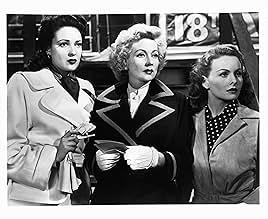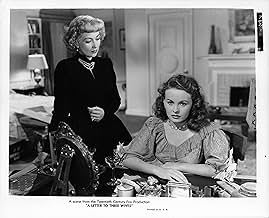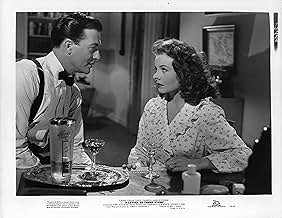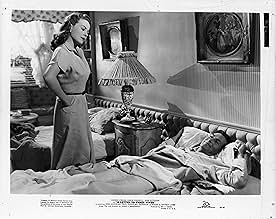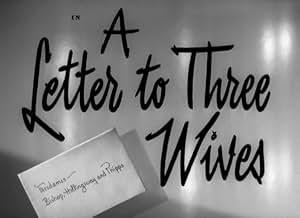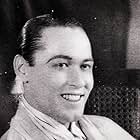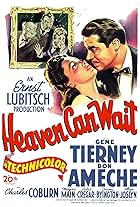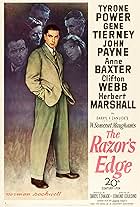A letter is addressed to three wives from their "best friend" Addie Ross, announcing that she is running away with one of their husbands - but she does not say which one.A letter is addressed to three wives from their "best friend" Addie Ross, announcing that she is running away with one of their husbands - but she does not say which one.A letter is addressed to three wives from their "best friend" Addie Ross, announcing that she is running away with one of their husbands - but she does not say which one.
- Won 2 Oscars
- 5 wins & 1 nomination total
James Adamson
- Porter's Butler
- (uncredited)
Joe Bautista
- Thomasino
- (uncredited)
Patti Brady
- Kathleen
- (uncredited)
Ralph Brooks
- Bookie Dancer at Country Club
- (uncredited)
John Davidson
- John
- (uncredited)
Sayre Dearing
- Country Club Member
- (uncredited)
Franklyn Farnum
- Country Club Member
- (uncredited)
Sam Finn
- Second Waiter
- (uncredited)
- Director
- Writers
- All cast & crew
- Production, box office & more at IMDbPro
Storyline
Did you know
- Trivia(at around 1h 16 mins) To get the proper look of derision from Linda Darnell in the scene where she stares at a photo of Addie, director Joseph L. Mankiewicz used a picture of Otto Preminger, the director who had given Darnell such a hard time on the set of Forever Amber (1947).
- GoofsIn one scene, a P-trap under a sink is shown leaking a huge amount of water. Being a drain, a P-trap would not leak unless the water was left on.
- Quotes
Mrs. Finney: Can't we have peace in this house even on New Year's Eve?
Sadie: You got it mixed up with Christmas. New Year's Eve is when people go back to killing each other.
- ConnectionsFeatured in The Screen Writer (1950)
- SoundtracksWein, weib und Gesang Op. 333 (Wine, Women and Song)
(uncredited)
Music by Johann Strauss
Waltz danced by Deborah and Brad at the country club
Featured review
Jeanne Crain was a very pretty girl, Ann Sothern was chiefly noted for her comic turns, and Linda Darnell was a memorable beauty--but although all three appeared in popular films none were particularly celebrated for their acting talents until Joseph L. Mankiewicz tapped them for the roles of three society wives in this poison pen letter to both sexes. Wickedly witty in script, and remarkably acid in tone, A LETTER TO THREE WIVES would put every one involved in the film firmly on the Hollywood map.
Three society wives (Crain, Sothern, and Darnell) are committed to hosting a children's picnic on an isolated island--and as the ferry prepares to depart they receive a letter from town femme fatale Addie Ross (never seen but memorably voiced by Celeste Holm.) Addie informs them that she is leaving town forever... but has decided to take one of their husbands along as a memento. And each of the three wives, cut off from the outside world for the day, is left to wonder: when I go home tonight, will my husband still be there? During the day each of the wives recalls scenes from her marriage. Deborah (Craine) arrived in town as a pretty but very awkward farm girl fresh out of the navy and with a wardrobe consisting of a single and very ugly mail-order dress; she has never felt entirely secure. Rita (Sothern) is married to a schoolteacher, and has committed the unpardonable sin of becoming the writer of a popular radio show that brings her more money than her husband will ever earn. And Lora Mae (Darnell) was a beauty born on the wrong side of the tracks who connived her way into a wealthy marriage and now specializes in bickering with her gruff and boorish husband. And always they have been victim to Addie--a woman who "has class," who stings them with competition and evil wit, and who has their husbands eating out of her hand.
Although the construction is artificial, the script is wickedly knowing, painting a truly subversive vision of American marriage and mores of the late 1940s. Of the three leads, Ann Sothern dominates with her spirited "Rita"--but Darnell has the best of the script, a series of manipulations and drop-dead quips and ripostes, and Crain is perfectly cast as the insecure beauty who is as out of place as a dove at a gathering of eagles. The supporting cast, which includes Kirk Douglas, Thelma Ritter, and Connie Gilchrist is remarkably fine as well. And before all is said and done, small town society gets raked over coals.
If A LETTER TO THREE WIVES has a flaw, it is the same flaw that would trouble Mankiewicz's later and even more celebrated ALL ABOUT EVE: the point of view that a woman is ultimately nothing without a man, an idea that tends to limit the scope of the film and at times even belittle its characters. Some viewers may also be disappointed with the film's conclusion, which--although extremely ironic--lacks the sharp bite you might expect. Even so, this is a truly memorable and often very funny film, and one that deserves to be seen more often today than it usually is.
Gary F. Taylor, aka GFT, Amazon Reviewer
Three society wives (Crain, Sothern, and Darnell) are committed to hosting a children's picnic on an isolated island--and as the ferry prepares to depart they receive a letter from town femme fatale Addie Ross (never seen but memorably voiced by Celeste Holm.) Addie informs them that she is leaving town forever... but has decided to take one of their husbands along as a memento. And each of the three wives, cut off from the outside world for the day, is left to wonder: when I go home tonight, will my husband still be there? During the day each of the wives recalls scenes from her marriage. Deborah (Craine) arrived in town as a pretty but very awkward farm girl fresh out of the navy and with a wardrobe consisting of a single and very ugly mail-order dress; she has never felt entirely secure. Rita (Sothern) is married to a schoolteacher, and has committed the unpardonable sin of becoming the writer of a popular radio show that brings her more money than her husband will ever earn. And Lora Mae (Darnell) was a beauty born on the wrong side of the tracks who connived her way into a wealthy marriage and now specializes in bickering with her gruff and boorish husband. And always they have been victim to Addie--a woman who "has class," who stings them with competition and evil wit, and who has their husbands eating out of her hand.
Although the construction is artificial, the script is wickedly knowing, painting a truly subversive vision of American marriage and mores of the late 1940s. Of the three leads, Ann Sothern dominates with her spirited "Rita"--but Darnell has the best of the script, a series of manipulations and drop-dead quips and ripostes, and Crain is perfectly cast as the insecure beauty who is as out of place as a dove at a gathering of eagles. The supporting cast, which includes Kirk Douglas, Thelma Ritter, and Connie Gilchrist is remarkably fine as well. And before all is said and done, small town society gets raked over coals.
If A LETTER TO THREE WIVES has a flaw, it is the same flaw that would trouble Mankiewicz's later and even more celebrated ALL ABOUT EVE: the point of view that a woman is ultimately nothing without a man, an idea that tends to limit the scope of the film and at times even belittle its characters. Some viewers may also be disappointed with the film's conclusion, which--although extremely ironic--lacks the sharp bite you might expect. Even so, this is a truly memorable and often very funny film, and one that deserves to be seen more often today than it usually is.
Gary F. Taylor, aka GFT, Amazon Reviewer
- How long is A Letter to Three Wives?Powered by Alexa
Details
Box office
- Gross worldwide
- $14,768
- Runtime1 hour 43 minutes
- Color
- Aspect ratio
- 1.33 : 1
Contribute to this page
Suggest an edit or add missing content

Top Gap
By what name was A Letter to Three Wives (1949) officially released in India in English?
Answer

